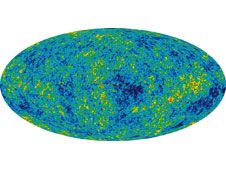Cosmos: The Cosmic Microwave Background
The image here of the Cosmic Microwave Background Radiation survey revealed the distribution of radiation and density of the universe when it was some 380,000 years old and a fraction of its present size.
The pattern confirmed what astrophysicists had predicted: that the background radiation in the universe was very smooth. The small but important differences in density across the entire universe are indicated by the colors. These differences represent quantum fluctuations at the time of the Big Bang.

The CMB proved that the universe began in an instantaneous expansion. The background radiation from that event spread evenly across the entire universe --much smaller than it is today-- and the radiation is still detectable today. It is traced to the time, 380,000 years after the Big Bang event, when photons were liberated as a result of a cooling universe. At that point the radiation pattern became "visible," although not in the optical range of light. The two surveys of the CMB (the second was the Wilkinson Microwave Anisotropy Map, or WMAP) solved two major puzzles about the Big Bang. The first was whether the universe in fact emerged in a single super-hot burst. The second question was the source of irregular densities in the primordial universe that eventually became the areas in which stars and galaxies would form.
The Cosmic Microwave Background (CMB) reveals the "quantum seeding" of the primordial universe, the minute fluctuations of radiation that the Big Bang spewed into an initially very small universe. As the universe expanded the traces of the distributed radiation were retained, so that tiny areas of density appear within an overall even pattern of radiation. The WMAP image shows that distribution at the time when the universe first became transparent, some 380,000 after the Big Bang event.
To scientists in astrophysics and related fields, the CMB image is a profound accomplishment. It confirms that the universe began in a single extremely hot flash. It shows the relationship between background radiation density differences and the subsequent development of galaxies in the areas of greater density. It is in those areas that hydrogen gas clouds massed that later formed the first galaxies and stars.
